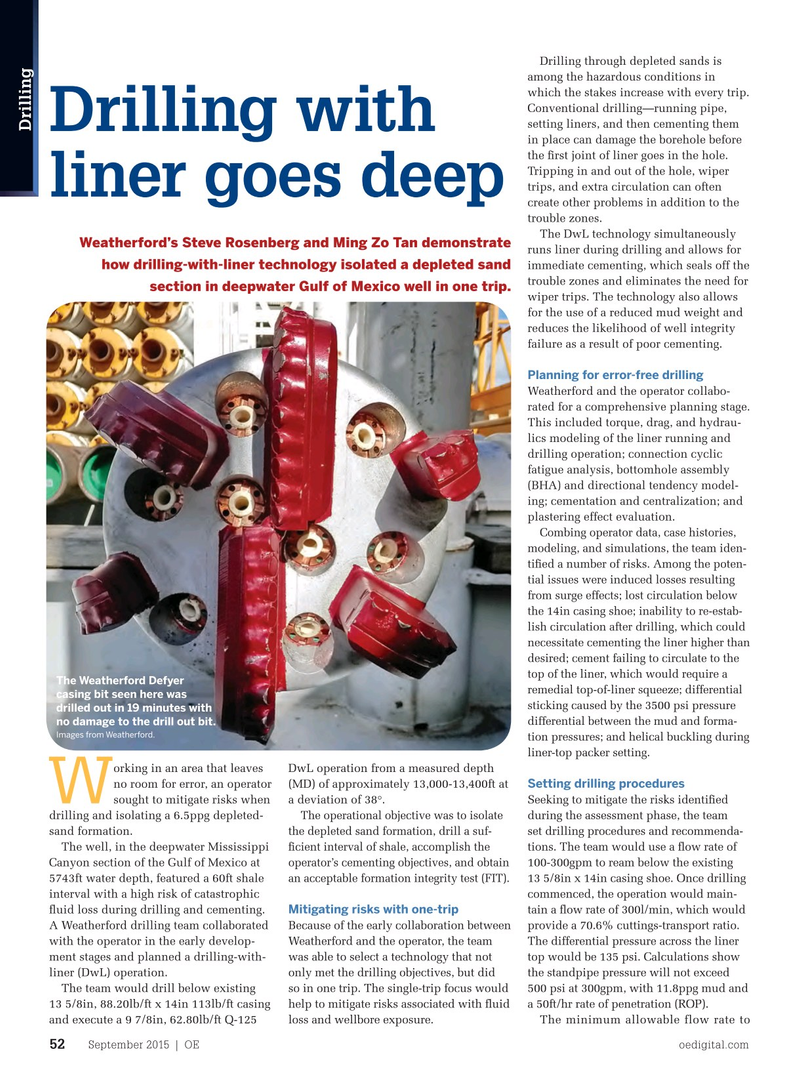
Page 50: of Offshore Engineer Magazine (Sep/Oct 2015)
Read this page in Pdf, Flash or Html5 edition of Sep/Oct 2015 Offshore Engineer Magazine
Drilling through depleted sands is among the hazardous conditions in which the stakes increase with every trip.
Conventional drilling—running pipe, setting liners, and then cementing them
Drilling
Drilling with in place can damage the borehole before the frst joint of liner goes in the hole.
Tripping in and out of the hole, wiper trips, and extra circulation can often liner goes deep create other problems in addition to the trouble zones.
The DwL technology simultaneously
Weatherford’s Steve Rosenberg and Ming Zo Tan demonstrate runs liner during drilling and allows for immediate cementing, which seals off the how drilling-with-liner technology isolated a depleted sand trouble zones and eliminates the need for section in deepwater Gulf of Mexico well in one trip.
wiper trips. The technology also allows for the use of a reduced mud weight and reduces the likelihood of well integrity failure as a result of poor cementing.
Planning for error-free drilling
Weatherford and the operator collabo- rated for a comprehensive planning stage.
This included torque, drag, and hydrau- lics modeling of the liner running and drilling operation; connection cyclic fatigue analysis, bottomhole assembly (BHA) and directional tendency model- ing; cementation and centralization; and plastering effect evaluation.
Combing operator data, case histories, modeling, and simulations, the team iden- tifed a number of risks. Among the poten- tial issues were induced losses resulting from surge effects; lost circulation below the 14in casing shoe; inability to re-estab- lish circulation after drilling, which could necessitate cementing the liner higher than desired; cement failing to circulate to the top of the liner, which would require a
The Weatherford Defyer remedial top-of-liner squeeze; differential casing bit seen here was sticking caused by the 3500 psi pressure drilled out in 19 minutes with differential between the mud and forma- no damage to the drill out bit.
Images from Weatherford.
tion pressures; and helical buckling during liner-top packer setting. orking in an area that leaves DwL operation from a measured depth
Setting drilling procedures no room for error, an operator (MD) of approximately 13,000-13,400ft at
W sought to mitigate risks when a deviation of 38°. Seeking to mitigate the risks identifed
The operational objective was to isolate drilling and isolating a 6.5ppg depleted- during the assessment phase, the team the depleted sand formation, drill a suf- sand formation. set drilling procedures and recommenda- fcient interval of shale, accomplish the
The well, in the deepwater Mississippi tions. The team would use a fow rate of operator’s cementing objectives, and obtain
Canyon section of the Gulf of Mexico at 100-300gpm to ream below the existing an acceptable formation integrity test (FIT).
5743ft water depth, featured a 60ft shale 13 5/8in x 14in casing shoe. Once drilling interval with a high risk of catastrophic commenced, the operation would main-
Mitigating risks with one-trip fuid loss during drilling and cementing. tain a fow rate of 300l/min, which would
A Weatherford drilling team collaborated Because of the early collaboration between provide a 70.6% cuttings-transport ratio. with the operator in the early develop- Weatherford and the operator, the team The differential pressure across the liner ment stages and planned a drilling-with- was able to select a technology that not top would be 135 psi. Calculations show liner (DwL) operation. only met the drilling objectives, but did the standpipe pressure will not exceed
The team would drill below existing so in one trip. The single-trip focus would 500 psi at 300gpm, with 11.8ppg mud and 13 5/8in, 88.20lb/ft x 14in 113lb/ft casing help to mitigate risks associated with fuid a 50ft/hr rate of penetration (ROP).
and execute a 9 7/8in, 62.80lb/ft Q-125 loss and wellbore exposure. The minimum allowable flow rate to
September 2015 | OE oedigital.com 52 052_OE0915_D&C3_Weatherford.indd 52 8/20/15 10:51 AM

 49
49

 51
51